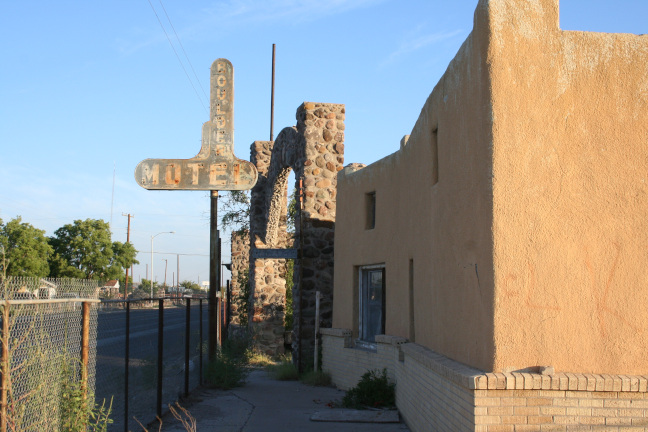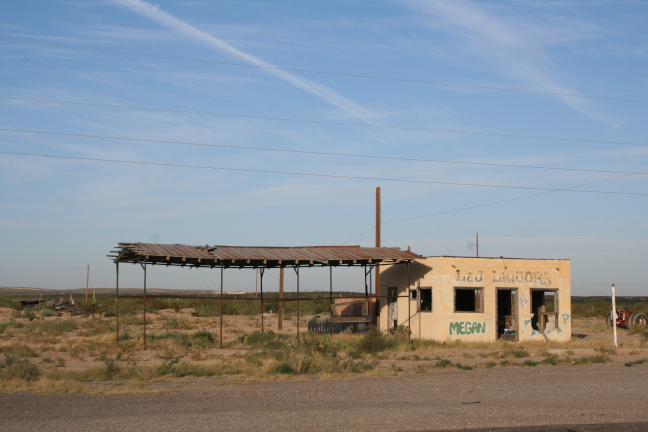Here are some pictures of Estancia Primera and of our particular neighborhood.
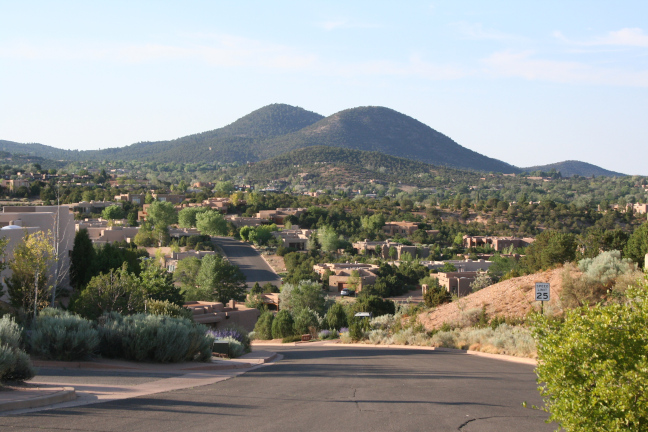
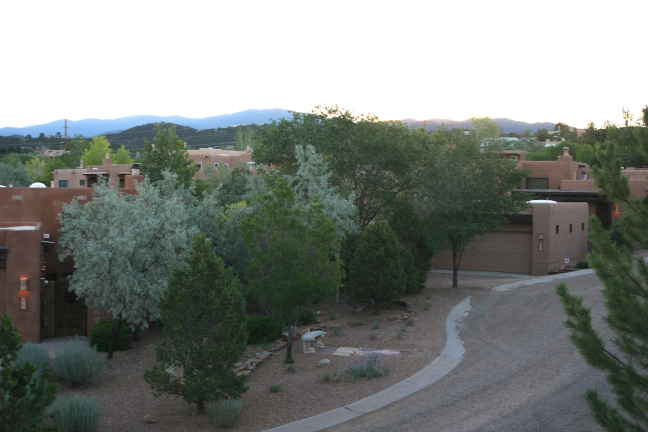
In 2009 we took a road trip from Arkansas to California. We were looking for a place to perhaps buy a second home, an eventual retirement home, and also visited dear friends in Tucson, San Diego and Santa Monica along the way.
As part of the trip, we re-visited Santa Fe, NM, a place we had visited in 1993 and had liked. At the time of our first visit, we had thought perhaps it might be a place to retire, but were concerned it was perhaps too small. At the time we were living in Ardmore, OK, population 20,000, so Santa Fe at 70,000 population was bigger and had a great art "scene", as well as an interesting mix of old Spanish, old Hispanic, recent Hispanic, and ancient Puebloan and Dine cultures. We wanted to take another look.
We found a realtor and did some looking, ending up with an offer on a small town house in a planned development from the 1980s just adjacent to the central downtowm part of Santa Fe and about a one mile walk from the Plaza, the heart of Santa Fe. We also looked in the Phoenix and Scottsdale area, but found nothing of interest there and were more than a little put off by the politics of Arizona.
So we ended up with a second home in Santa Fe in late 2009. Because Gene could telecommute for some of his work and the rest involved air travel anyway, he was able to get to Santa Fe several times a year, and Ellen could join him for holidays and the summer vacation. But we found out that being an absentee house owner was not a great situation when, even though we had hired a property manager, we had a roof leak during a severe winter and had the dining room ceiling collapse. Despite his frequent checking, the leak developed quickly, but he was able to greatly mitigate the damage. We ended up, however, with a new roof. Even though the roof on the house had been completely re-done a year or so before we bought it, the job was not done properly and further was done over other improperly installed roofs. And therein lies a Santa Fe story about the down-side of home ownership in Santa Fe, and particularly about the Santa Fe roof.
As we discovered after moving there, much of the city of Santa Fe was built in the "pueblo style", and in most of the downtown, that was one of two "styles" of residential building permitted. This was the basis of the particularly charming look of Santa Fe and was an architectural style concocted in the 1920s 1930s largely by people at the University of New Mexico Art Museum in Santa Fe, a couple of architects, local artists, and some politically persuasive businessmen. The style was to evoke the look of older Native American pueblos, particularly Taos. It features stucco walls, exposed wooden beam-ends, and relatively flat roofs. Although originally constructed with adobe, these days it is largely stucco over frame construction.
And, although the pueblo revival style can be attractive and the zoning requirements make for a pretty harmonious look of most of the city, over time, one tires of the relative similarity of stucco colors and the somewhat blank look of the walls around yards and patios. But more than that, the impracticality of stucco, a masonry based product, and of exposed wood, often stained dark colors, in the extremes of Santa Fe weather, which runs from drenching rainfall in the summer "monsoon" through blistering heat and low humidity in the rest of the summer to winters with heavy snowfall and subzero temperatures makes for a maintenance nightmare for the homeowner. Add to that the flat roofs most of which drain through "canales", the projecting wooden spouts along the edges of the roof, which canales freeze up in winter and block the water flow from the melting snow on the roof. Well, you get the picture.
About a year after we purchased the Santa Fe home, Gene's employer transferred him to a different territory, one that included New Mexico. This decision was hinted at in October, but not finalized until December 16th with a start date at the new assignment of January 6, 2011. Fortunately we had already sold our house in Fayetteville and moved into a rented apartment in nearby Rogers, and also fortunately, the Rogers apartment complex had an "out-clause" in the lease with a no cost lease termination if the renter were transferred by his or her employer. Rogers is a town next to Bentonville, the headquarters of Wal-Mart, so we had that fact to thank for the out clause.
Less fortunate was the short notice given of the new assignment and the need to pack up and move from Arkansas to New Mexico over the holiday time. And equally unfortunate, since the employer knew we had a second home in Santa Fe already, there was not moving assistance made available to us. But we managed. Ellen gave notice at her library job and Gene packed and moved the household goods. His trip in a huge U-Haul was pretty smooth, but Ellen and Rob, driving out, got caught up in a massive snow storm in Oklahoma, spending a couple of days in a motel in eastern Oklahoma, eating Christmas dinner at the nearby "Pig Out Palace", before getting back on the road, only to hit a patch of black ice in Oklahoma City and do a 180 turnabout on the Interstate. Fortunately, there was no collision, although the pyschic trauma was great. They made it, finally, in time for a post-Christmas party in the neighborhood. Although the PTSD proved stronger than any party.
Our home was a town-house in a very nicely laid out development from the 1980's and 90's. It is called "Estancia Primera" and was originally designed as clustered housing with large amounts of the land left "wild". The site had been a huge gravel and sand "borrow pit", so was contoured a a large bowl, bordered by the city proper on the lower end, and two main roads leading out of the city on the sides. With the slope of the land, drainage and run off from the occasional severe storm was an issue from the beginning, but the early development had taken those issues into account and designed complex systems of check dams and water impoundment areas to control flooding below the development. So the older parts of the development consisted of two and three unit town houses clustered around a cul-de-sac road and surrounded by arroyos and dense pinon pine.
The development struggled financially for a decade or so, but finally hit critical mass sometime in the 1990s, as the housing market evolved toward larger, single family dwellings. This latter trend resulted in later "neighborhoods" of larger, free-standing homes, especially around the periphery of the development. Although the "spirit" of the original design was altered, the overall effect was still to cluster the housing densely and leave as much land as possible undeveloped.
Here are some pictures of Estancia Primera and of our particular neighborhood.


In the background of the picture of Estancia Primera, you can see the two hills, known locally as the "Sun and Moon". It always looked to me, from this vantage point, that the earth was "mooning" the sky.
The view of our neighborhood road was taken from our roof on one of the many climbs up for maintenance and repair. The road was gravel and subject to damage from heavy rains, with much of the gravel ending up at the bottom of the slope upon which the neighborhood was built. The road was the high ground, and each house sloped down, built into a side hill, with the rear facing one of the two arroyos that bordered the side of the neighborhood. At the bottom was the main arroyo, which funneled water down toward a major collecting waterway maintained by the city.
One of the nicest aspects of the neighborhood and much of adjacent Santa Fe, was the abundance of walking trails. Estancia Primera had a couple of trails wandering through it and connecting with trails in other neighborhoods or with city-maintained trails within the downtown city. We walked along some of these trails from our house to downtown, the Plaza, and the many coffee shops and other places to visit. Over the several years we were there, however, attitudes changed as new people moved into town, and by the time we left, there were no trespassing signs appearing on the trails, even those that were deeded as open to the public. The fearful mentality of the "gated community" became more generalized in the city. Even in our little part of Estancia Primera, a no trespassing sign sought to interdict a commonly used walking path to the arroyo.
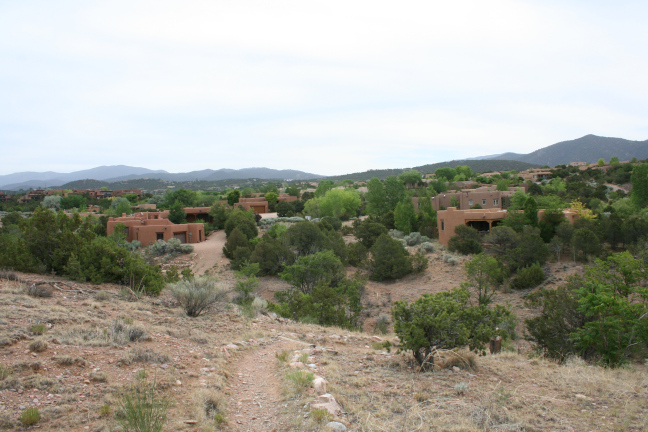
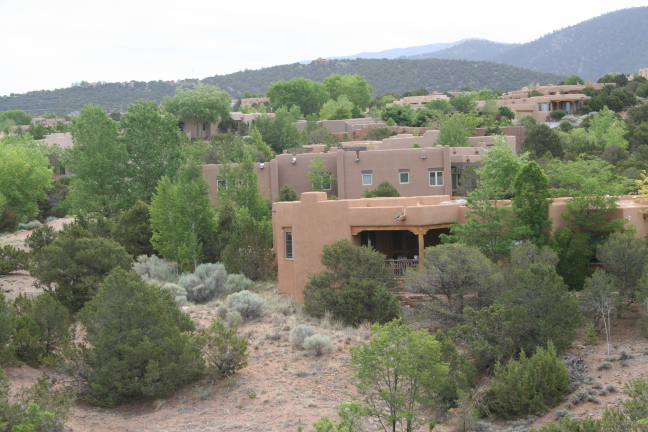
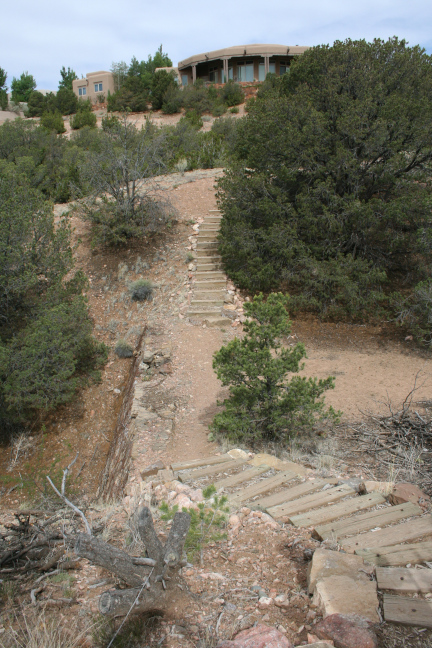
Our house had been built in the 1980s and incorporated many of the features that became the "Santa Fe Style". There was Talavera tile in the kitchen and bathrooms and mock-saltillo tile on the floors. The outside was stucco, of course, and the roofs were flat. And the wood trim was stained dark brown. All these features made the building pretty much unsuited for the extremes of the seasons there. Summers were hot and dry with intense sunshine, and the winters were cold with plenty of snow. Which was hard on the stucco, the wood, and the roof. So owning a home there turned out to be pretty constant maintenance. Another reason to give up the American dream of home ownership, which we did when leaving Santa Fe.
Here are some pictures of the house, inside and outside.
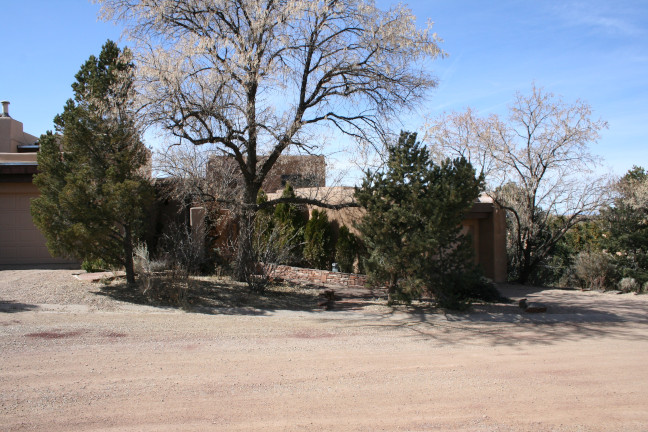


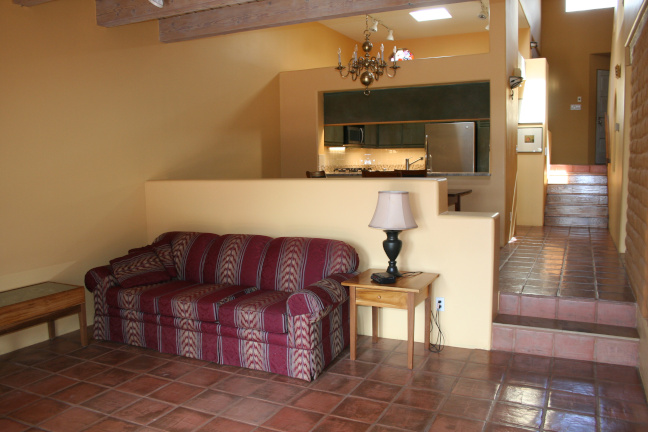
Some pictures of the Talavera tile in bathrooms
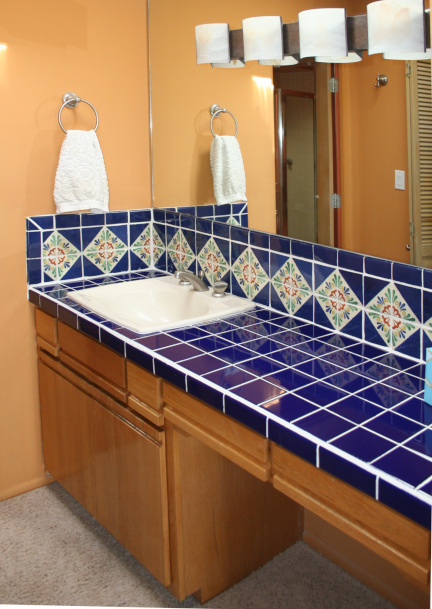
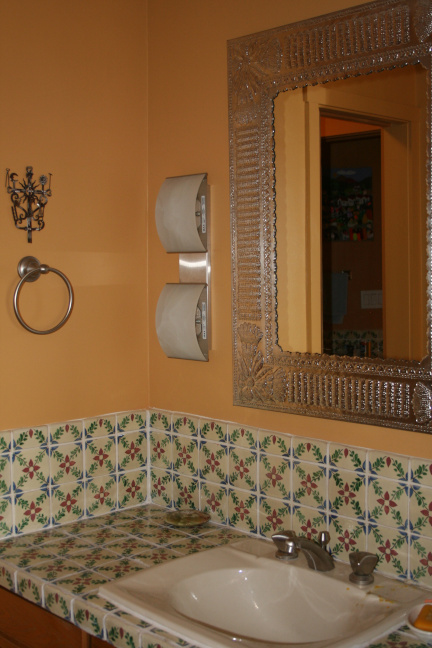
The house had lovely views. There was a front window on the second level that looked to the northeast, and the windows on the back looked over Estancia Primera, the City of Santa Fe, with the mountains in the background.
The first picture shows the view that greeted one when going down from the second floor bedroom to the kitchen for morning coffee.

These photos show the view out the back windows, which looked to the west.
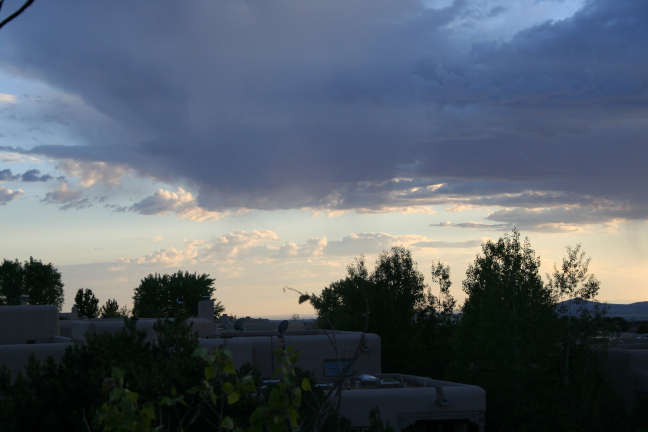
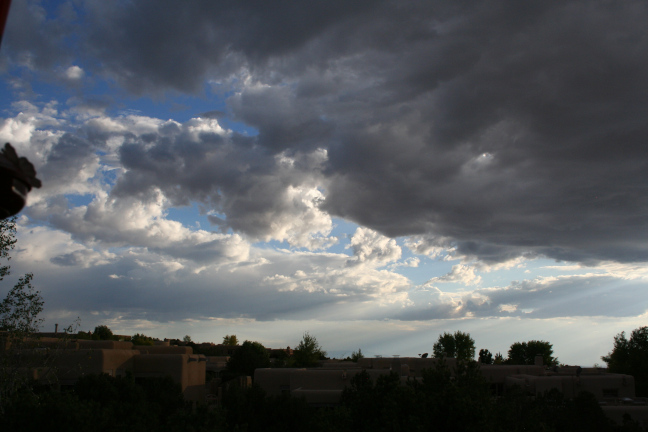


The house had two patios. One was behind the guest bedroom surrounded by a wall. The other ajoining it, lay behind the living room and ovelooked the small arroyo behind the house. It was mostly bordered by pinon pine trees, which provided a nice screen, some shade, and habitat for various creatures, from the resident chipmonks, later supplanted by gray squirrels, to the many migrating birds, including humming birds. Here are some photos of the patio in various seasons.
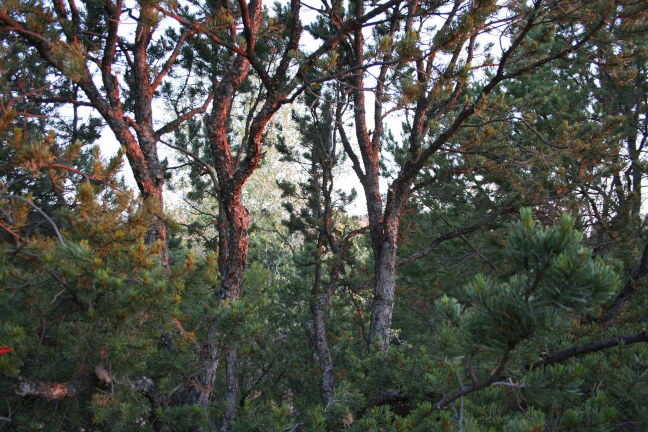
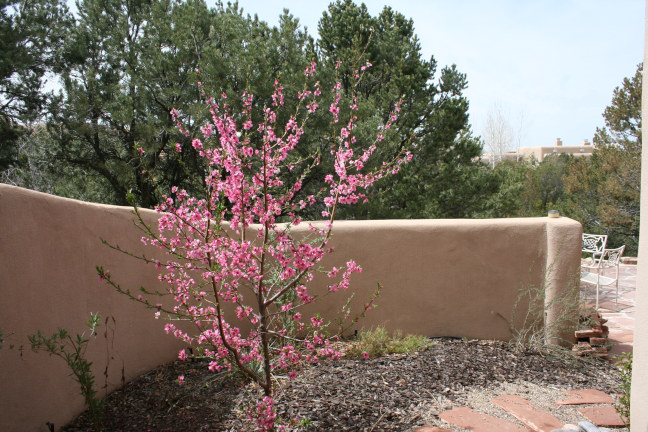


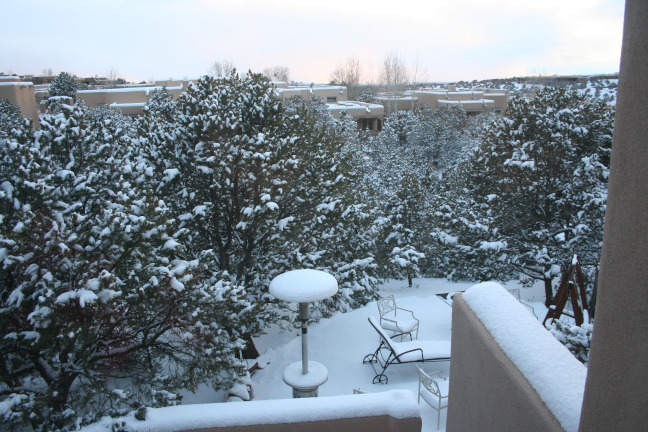
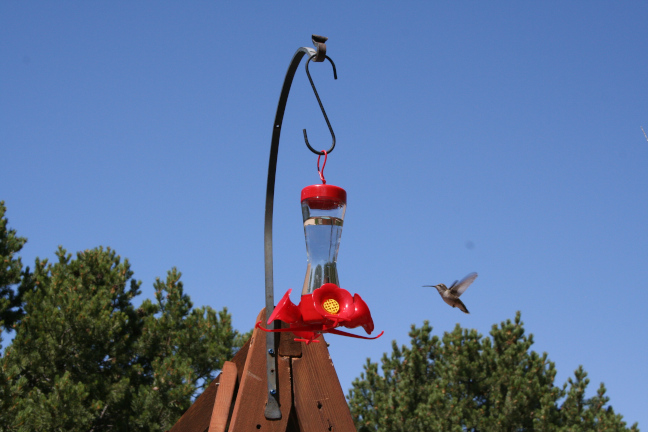
With the rather sudden need to move full time to Santa Fe in December of 2010, we pretty quickly realized that we needed some extra space. So we added a room to the second floor of the house to make space for our various craft activities as well as for an office. We included plenty of shelves for our book collection and had room for an etching press and for Ellen's fibre arts.
Here are some pictures of the rear of the house, before and after the addition, and some pictures of the new room we added.
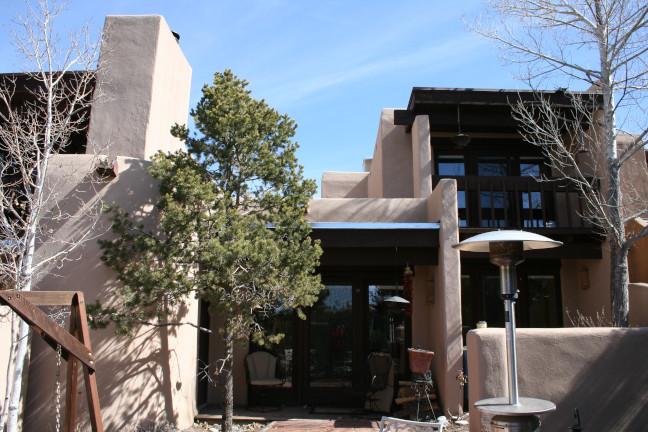
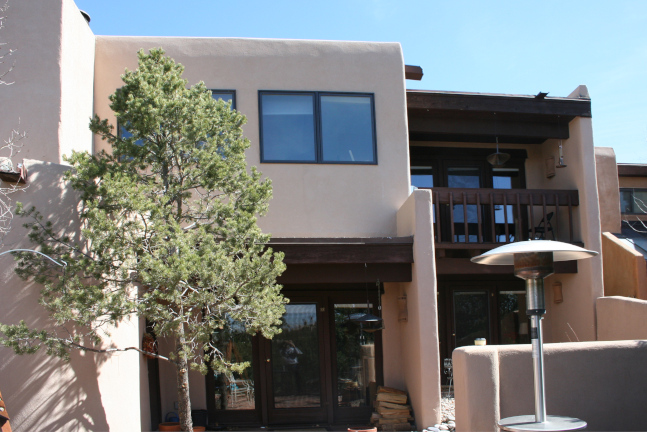
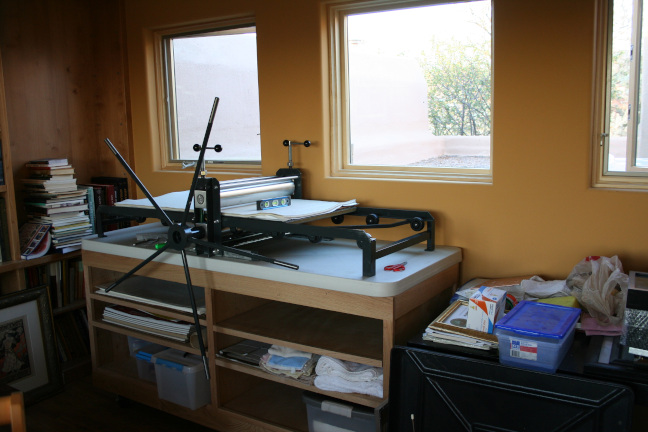
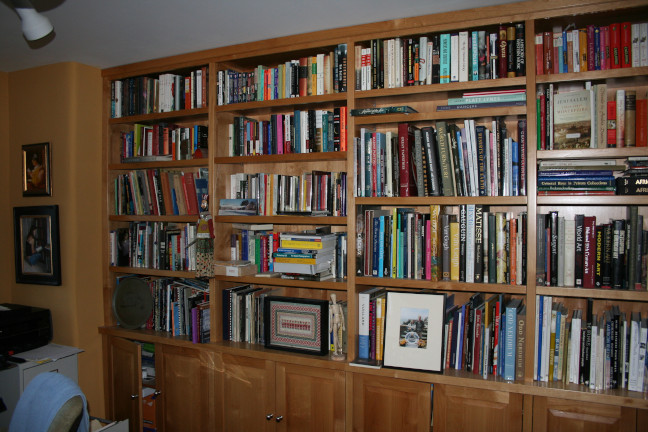
Much of the city of Santa Fe has unpaved streets, particularly in older neighborhoods. Many, perhaps most of these streets were private, as was ours. So the maintenance of the street, and snow removal, was the responsibility of the owners. Which partly explains why snow removal was so poorly done in Santa Fe, resulting in icy streets and even icier sidewalks, particularly as few residents bothered to clear their walks.
Since we did long walks daily, we found the conditions in winter dangerous and that we were often house-confined by heavy snows or icy conditions.
Although Ellen enjoyed being retired for a few months as we spent our first winter in Santa Fe, it was a temporary rest. Our cat adjusted to the new home and enjoyed playing on the open stairway and watching the many chipmonks playing on our patio. And thinking grand thoughts.
Before long, Ellen found a job as an administrative assistant at Santa Fe Pro Musica, a local non-profit which had a small orchestra and put on multiple concerts featuring guest artists in the fall, winter, and spring seasons. The music director, Tom O'connor, had a gift for finding young up and coming performing artists and bringing them to Santa Fe. Through Ellen's work with Pro Musica, we met a number of emerging and established musical performance artists including Per Tengstrand (piano), Rachel Podger (baroque violin) Chad Hoopes (violin), Jan Lisieki (piano), and Conrad Tao (piano). It was pretty thrilling to meet and hear these folks, and others, and we also attended concerts by the Santa Fe Symphony and programs from Performance Santa Fe.
But two additonal great discoveries made the summers in Santa Fe especially fine.
The first is the Santa Fe Opera. This is an open-air performance venue which has interesting and exciting seasons from early July to late August each year. The Opera puts on several of the classic operas, several newer or less frequently performed works, and at least one premier performance of a new, often commissioned, work each season. The productions tend toward the innovative, almost avant garde, in part due to the unusual stage, which lacks the flys of a traditional theatre, and is open in the back to the view of surrounding hills and nearby mountains. The Company has a huge apprentice program for performers (soloists, chorus, dance) as well as apprentice programs in all the support functions needed in opera, stage management, lighting, sets, props, costumes, and more. There is also a large volunteer program with volunteers serving as ushers and docents for daytime tours, and also working in the costume shop and the prop shop. We volunteered in the prop shop for a while, but found our volunteer home in the costume department. It is really fun to meet young (and some older) people who are making a career in costume design and fabrication in the world of theatre. We made some great friends there and did our bit sewing snaps onto garments, and one year, knitting chain mail armor out of nylon seine twine. In exchange for the volunteer hours, we got to attend the final dress rehearsal of each opera in that season. We were certainly overpaid, as we got to see some splendid shows. Not only some of the standards, but also premiers of new shows such as "Cold Mountain" and "The (R)Evolution of Steve Jobs", and a new production of "Dr. Atomic".
Even after we moved from Santa Fe, we returned in summers (until 2020 and Covid) and worked in the costume shop. And saw some operas.
The second great discovery was the Santa Fe Chamber Music Festival. This runs from mid July to late August every year, concluding the weekend of Indian Market. We discovered it quite by chance, when Gene and a visiting friend happened upon an open rehearsal when at the New Mexico Museum of Art. Most of the performances, except the final week or two, are in the St. Francis Auditorium, a chapel-like venue in the Museum. The setting is intimate and perfect for chamber music, solo recitals, and small choral works. We began attending regularly in 2011 and gradually worked our way into prime front row seats over the years, attending 20 - 25 concerts each season through 2019. Covid cancelled the 2020 season, alas, and we decided not to return for the following season.
Although Santa Fe had more to offer than most cities of 70 K population, and the summer weather was spectacular, and almost every day was sunny, we found over time that it was really pretty small. The downtown areas where most of the venues and events were located was small and walkable, which was nice, and changed little over time, which was comforting to returning visitors, it eventually acquired a same-ness that evolved to ennui, then to a mild boredom. It did not help that during the best times of the year the city was packed with visitors or that the wonderful Plaza was so often given over to large scale events which were out of character with the city and the Plaza itself. And we also found that the winters were severe enough to greatly restrict our favorite activity, walking. The city has significant snowfall, but most of the time, any snow accumulation melts away in a day or so. The city has narrow, winding streets, many unpaved, many private roads, so snow-removal is limited, at best, to only major thoroughfares. And few residents bother to clear their sidewalks, which quickly become ice covered and dangerous. Santa Fe residents seemed content to wait a few days for the snow to melt rather than clear it away. After a few slips and falls, we had to give up our daily walks during snow/ice season, a restriction that chafed considerably.
Also, we had soon found out that much of Santa Fe particularly around the cultures that intersect there is invisible. The Pueblo cultures are still very alive and vibrant, but largely closed to non-Pueblo peoples. Although many area pueblos have seasonal public dance ceremonies, these are more performances rather than a sharing of meaning or tradition. The situation with old and new Hispanic cultures was much the same. Much of the area of the city was outide the designated historic district, with its rules and regulations on architectural style and stucco color, and was where most of the residents of Hispanic or Latin heritage lived. As the city prospered and became increasingly a population of part-time residents, older Spanish neighborhoods were incorporated into the expanding "downtown" and the residents displaced, as multi-generational family homes were converted to housing for part time residents, both as second (or third) homes, summer residences, or rental properties. Local building regulations allowed conversion of small properties to condominiums with looser rules and building codes. Condominiums with two or three or four units were common, and they lacked the financial capacity in many cases to handle major repairs or renovations, when they were needed. Since, for us, one attraction of Santa Fe had been its multi-cultural history and the hope that it would be possible to learn more about it and the various traditions that intersect there, it was a disappointment to find that much of the history was hidden, many of the cultural traditons nearly invisible. Both probably simple survival techniques developed against the on-going onslaught of the dominant American society. As one puebloan observed to us, "The Spanish came and took everything away from us, and now, they are losing it all to the Anglos. I almost feel sorry for them."
So, a couple of years after we both retired and found that being full time in Santa Fe was wearing thin, during a time we also discovered that the medical care in a small city is not always the best, we decided to make a change, and move back to New Orleans, a city where cultural traditions are always on display, and history, good and bad, is discussed constantly. A city big enough and troubled enough to promise that boredom would not be a problem.
Before we moved on, during our years in Santa Fe we explored the town itself and made day trips to places nearby. There truly is a lot to see there and the environs can be spectacular.
We visited Bandelier National Park near Los Alamos, which led to a trip to Chaco Canyon, a bit of a longer trip, but well worth the time and travel. This supplemented our reading about and interest in puebloan cultures as well as visits to nearby pueblos and attendance at pueblo dance ceremonies. We soon realized that most of the belief system and cultural practices of the puebloan peoples are largely unknown to non-indian people. The pueblo tribes had survived by remaining to this day pretty secretive about their culture. We also learned that the pueblos and the Dine (Navajo) are ancient enemies and even today, there is tension among them.
Here are some pictures from our visit to Chaco Canyon, a place which is pretty mysterious, although certainly not to the puebloan people. The peoples who lived there not only build incredibly sophisticated stonework buildings and harvestedd timber from long distances away but they also built complex water diversion and impoundment systems to capture rain water and surface water run off to ensure a water supply for the whole community. The farmed the surrounding arid land and stored crop surpluses in community storehouses for lean years. And they constructed many "kivas" of differing styles. The purposes and details of use of the kivas remain largely unknown, at least to non-Indians.
The settlement flourished about one thousand years ago, becoming the center of what is referred to as the "Chaco Culture", and this location was connected by many roads to over one hundred other settlements in the regions. Chaco itself may have been a ceremonial center, which might explain the many kivas and the large "parade ground" like open spaces surrounded by multi-story buildings. But the facts remain unknown to non-puebloans.Toward the end of the peak period of Chaco, other peoples, including the Dine, moved into the region. These other peoples were often "warrior cultures" and gradually raiding of the pueblos increased. Whether or not this had some role in the rather abrupt abandoment of the Chaco site by puebloans is not known, but after its abandonment, the Dine moved into the site and it also became an important part of their history and culture.
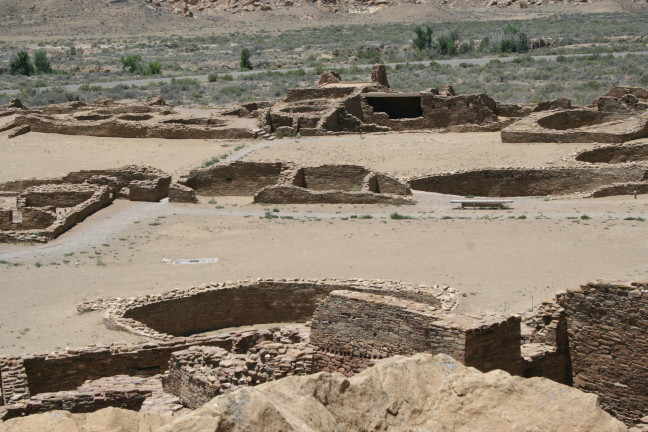
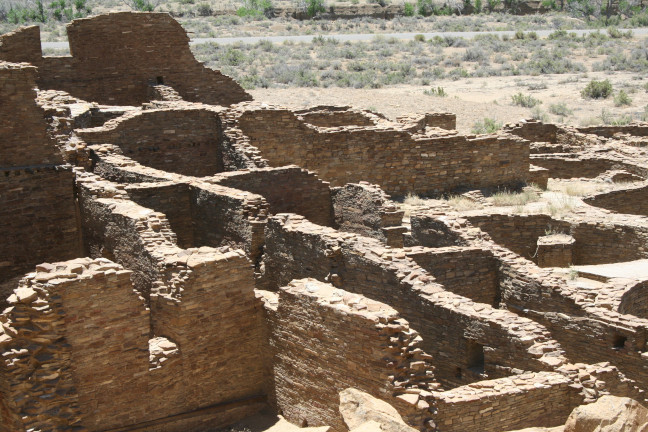

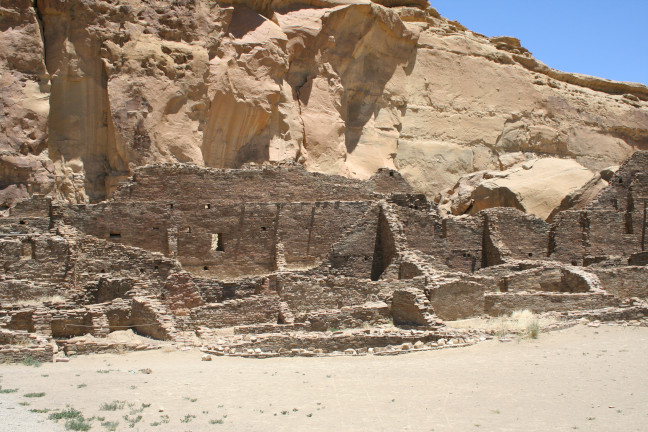
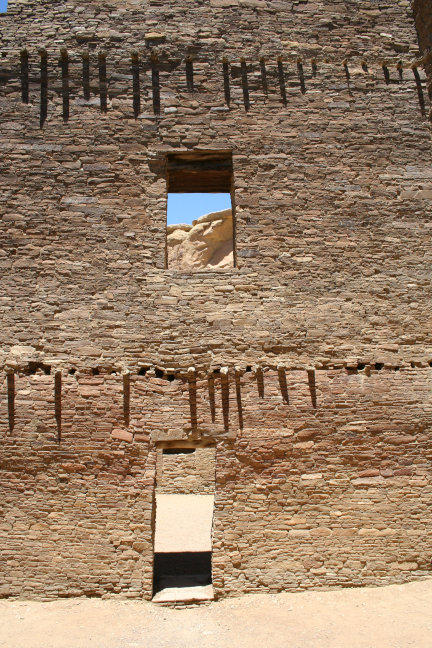
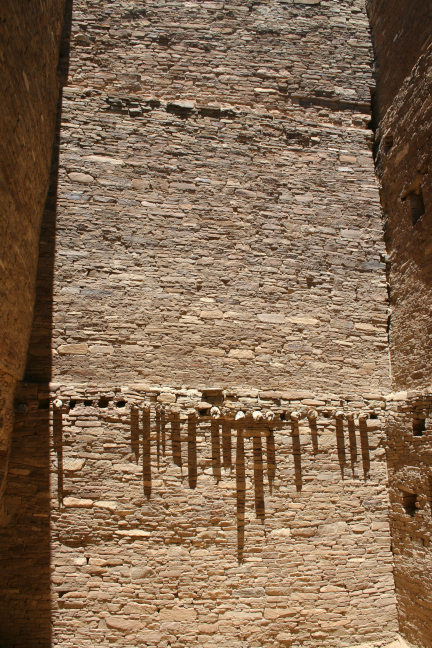
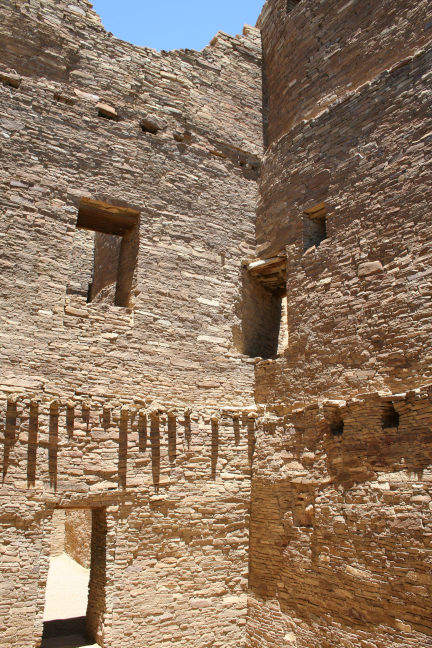
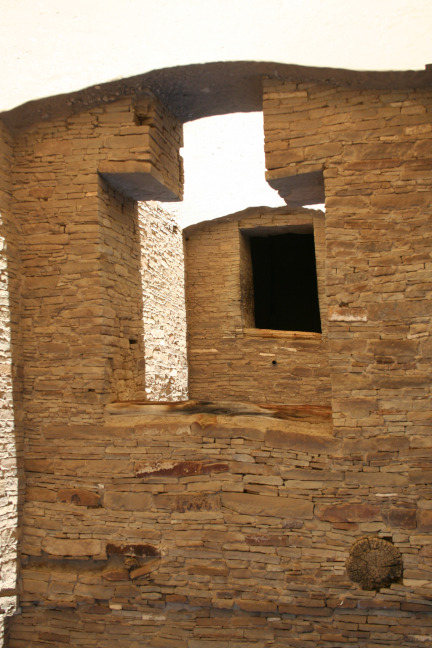
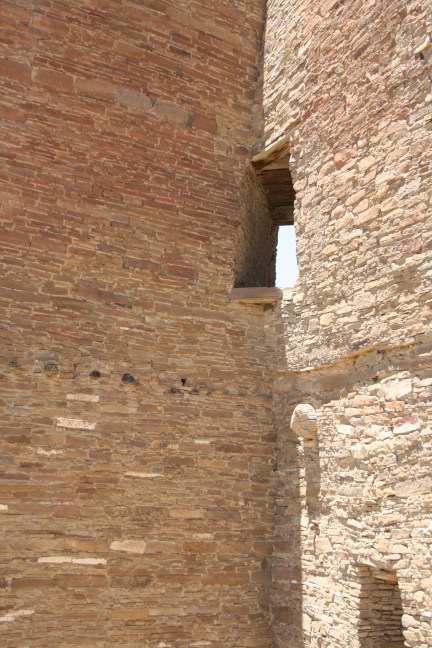
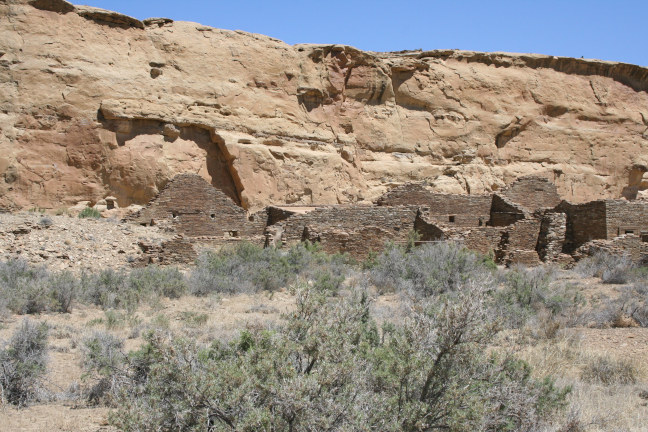
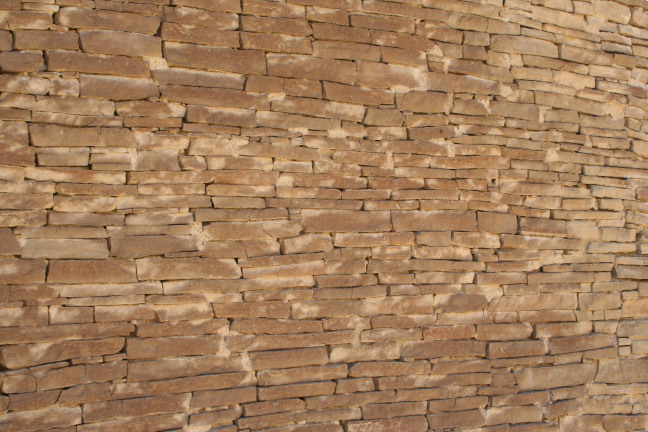

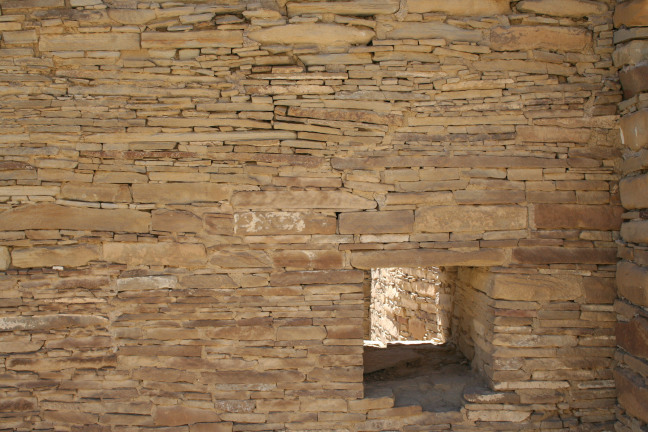
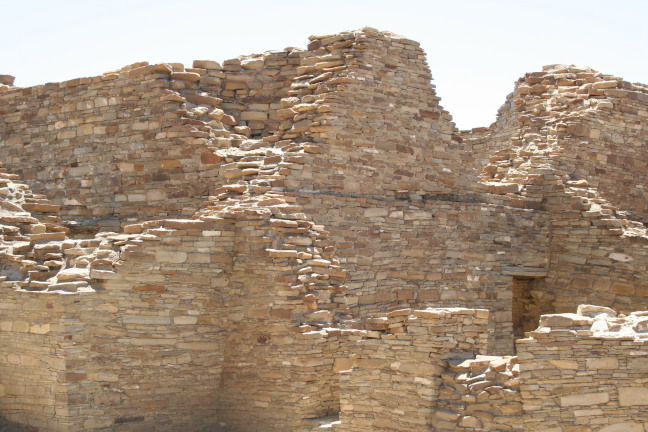
History of Evangelo's Bar and Evangelo
There seemed to be plenty of mysteries in Santa Fe and the area, and one of the more interesting ones involved a bar in downtown Santa Fe named "Evangelo's) and its original owner, Angelo Klonis.
The bar was a long time staple of nightlife downtown and featured live music most nights, but, of course, it being Santa Fe, the music rarely played late into the night.
The most notable thing about the place at first glance was the sign hanging above the main entrance.
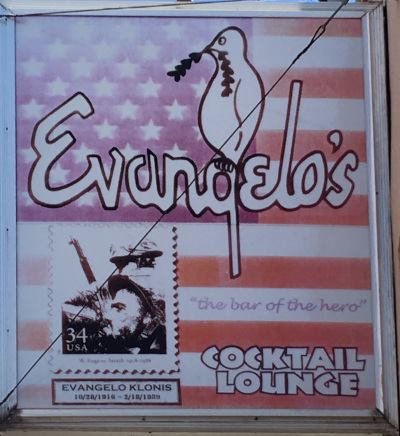
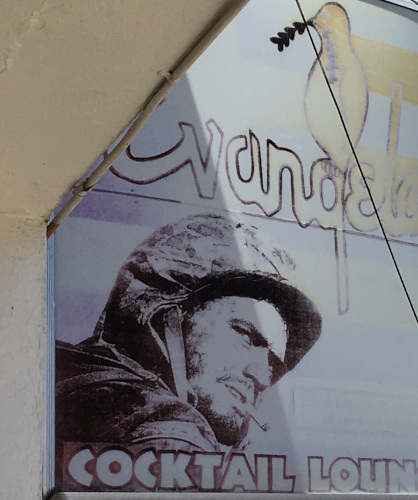
The photographs on the sign are two well known pictures taken during WW2 by the famed photographer, Gene Smith. And the man in the photos is Angelo Klonis. Angelo was a Greek immigrant to the US who served in the military during WW2. He had returned to New Mexico after the war with the ambition to open and run a bar, which eventually he did.
Angelo stowed away on a ship bound to Los Angeles at the age of 15 and made his way through the west to Santa Fe where he spent most of the 1930s working in restaurants there. He volunteered for the US Army after Pearl Harbor and returned to Santa Fe after the war, working in the restaurant business again. He returned to Greece in the 1950s and met his wife there. He and his wife came back to Santa Fe and eventually he bought his own restaurant/bar.
Angelo did not talk much about his experiences in the war. He said some things about being in Norway and at D-Day in Normandy, but his discharge papers indicated only that he had served in North Africa and Europe. He did mention that he had met and been photographed by a photographer from Life magazine and often asked his family to look for the photographs taken at that time. Angelo died in 1989 before the family saw the famous photograph and recognized him as the man in the picture.
There were a couple of problems, however. The picture was taken on Saipan during the "Battle of Saipan", which was June 15 to July 5, 1944, and later, when the original Smith photo was reviewed, Smith, who was careful to document clearly persons in his photos, had indicated this person was a PFC "T E Underwood" of the US Marines. But Angelo was in the Army, and is known to have participated in the D-Day invasion, June 6, 1944, landing on Omaha Beach.
The Klonis family began a long effort to find out more about Angelo's service. And eventually located the widow of a John Ray Underwood, who had been a "commando" during the war and had mentioned serving in a special unit with a Greek friend who had saved his life in Saipan. This Underwood had survived the war and had told his wife about some of the missions undertaken by his unit. They even visited New Mexico in the late 70s looking for his Greek friend, but did not find Angelo. Underwood's widow also reviewed the several pictures taken by Smith in Saipan and identified her husband as the second soldier seen in some of them, but not the individual seen in the most famous two pictures.
Other people dispute this account and maintain that the photo is of Marine TE Underwood and a group of Marines and not of Angelo and John Underwood, of the Army. The soldier drinking from the canteen wears a Marine camouflage helmet. And Smith is known to have accompanied a squad of Marines during his trip to Saipan.
Whatever the truth of the photographs may never be known, but it makes a good story. And we are still left with the mystery of how and why a special unit of the Army which participated in the D-Day landings on June 6 was relocated to Saipan and photographed by Smith on the 27th of June.
Either way, a visit to Evangelo's these days will give you the opportunity to review a wall of memorabilia behind the bar there. If you are lucky, you may get the chance to meet and talk with Nick Klonis, Angelo's son and keeper of the flame.
Nearby Ghost Towns and Nearly Ghost Towns
Often when traveling by car from Santa Fe to New Orleans or the reverse, we might choose an alternate route to avoid long stretches of Interstate highways. One of the routes was to take US 285 south from Santa Fe to Vaughn, NM, then travel US 60 through Fort Sumner to Clovis, NM, then pick up US 84 at the Texas border and travel southeast to Lubbock. If you have seen the movie "Hell or High Water", you will recognize the names of the Texas towns along that latter route.
Once on 285, south of Interstate 40, you travel a long stretch of 4 lane divided highway virtually without traffic or cell phone coverage. Encino is the first settlement you encounter.Encino is a small town, which had a population of about 500 people at its peak in the 1940s and 50s but declined dramatically beginning in the 1960s. About 40 or 50 people still live there, but most buildings are abandoned. It appears to have once been a market town for surrounding homesteads and ranches rasing sheep and cattle in large numbers. The Atchison, Topeka, and Santa Fe railroad established a depot there in 1905 and until the 1960s, when the depot closed, Encino was a bustling town.
Here are some pictures of Encino from 2013.
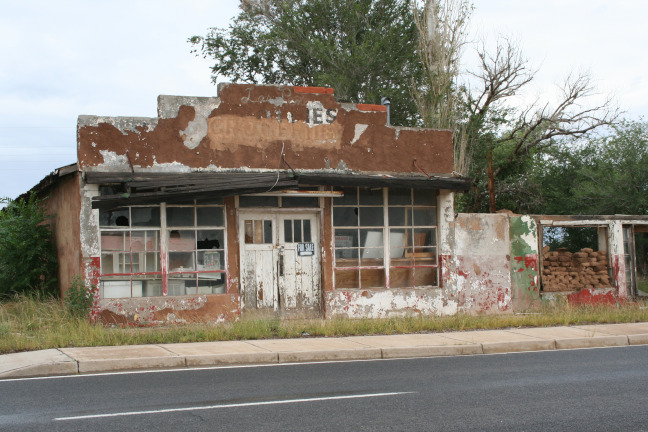
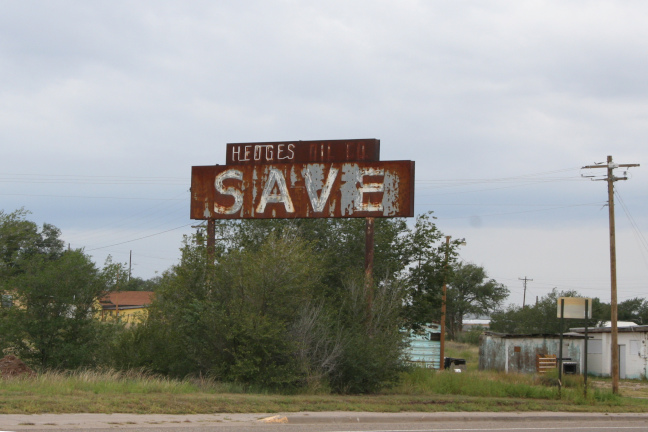
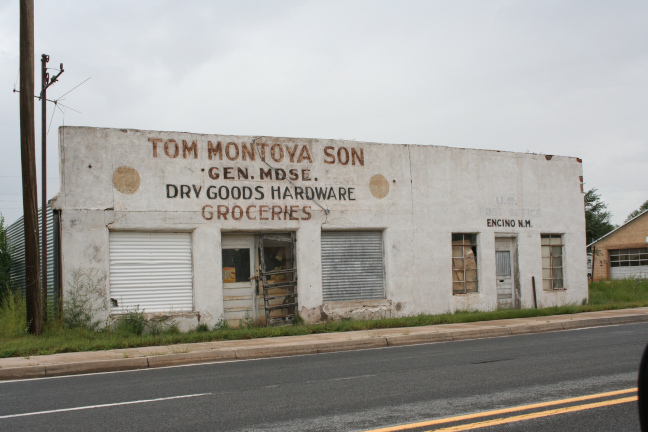


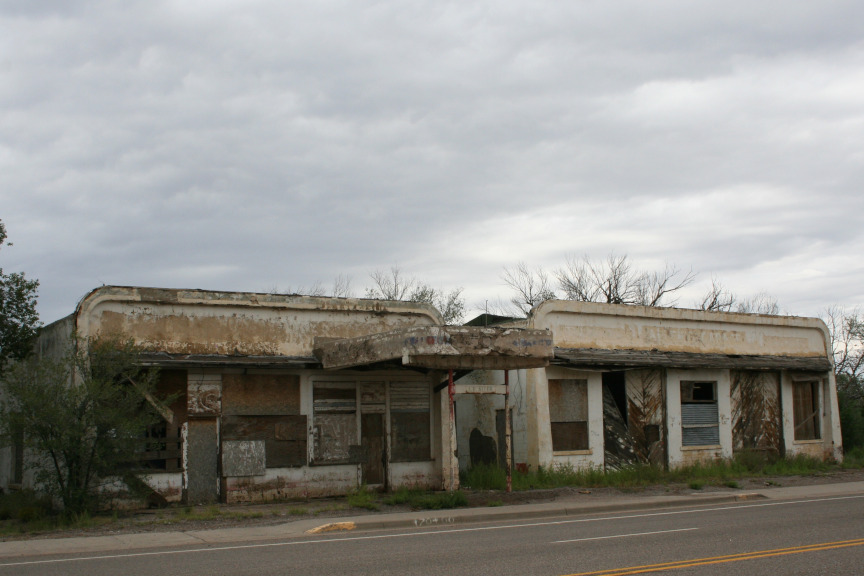
Route 285 continues east to Vaughn, NM, and Route 60 splits off there to continue on to the Texas border. Vaughn started in the 1880s as a stopping place on the Stinson cattle trail and later became a Southern Pacific Railroad town. It became more important in 1907 when the Atchinson, Topeka, and Santa Fe Railroad also came to Vaughn on its way from Behlen to Clovis, establishing Vaughn as a division point with a two story depot and a roundhouse. It was one of the few towns where two railroads crossed and three highways intersected. The town was incorporated in 1919 and had a population of almost 900 by 1920. It even had a Harvey House Hotel, the Los Chavez Harvey House, founded in 1910, and closed in 1936.
Vaughn grew slowly in the 1930s and 40s to a peak population of about 1500 in the 1950s. With the decline of railroads in the 1960s, Vaughn declined also and its present population is about 400. Most of the abandoned buildings are still standing and Vaughn, along with Encino, is a photographer's paradise. There is still a very traditional stainless steel diner operating there, along with a couple of gas stations and motels. The Diner is near the intersection where route 60 splits off from Route 285.


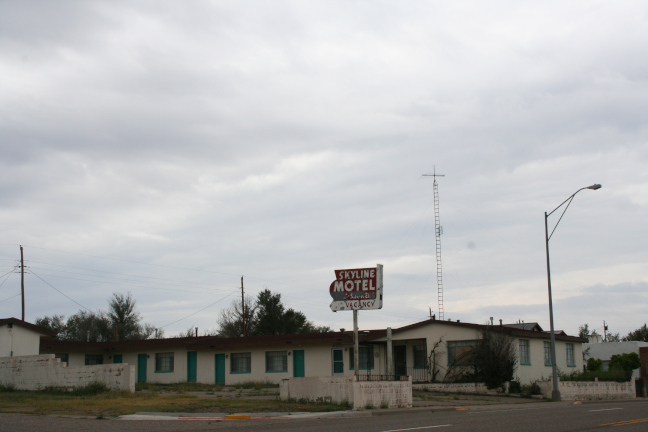
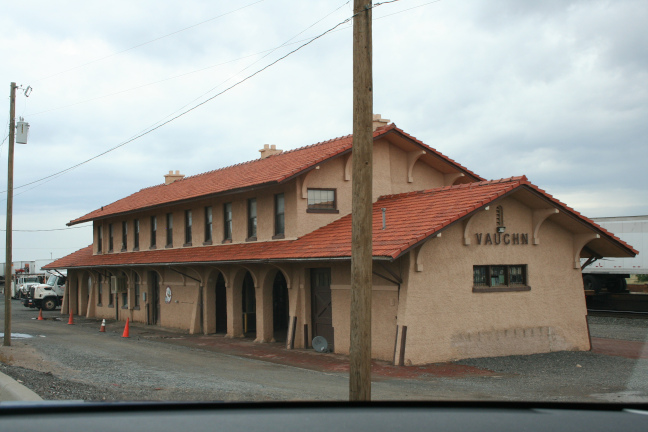
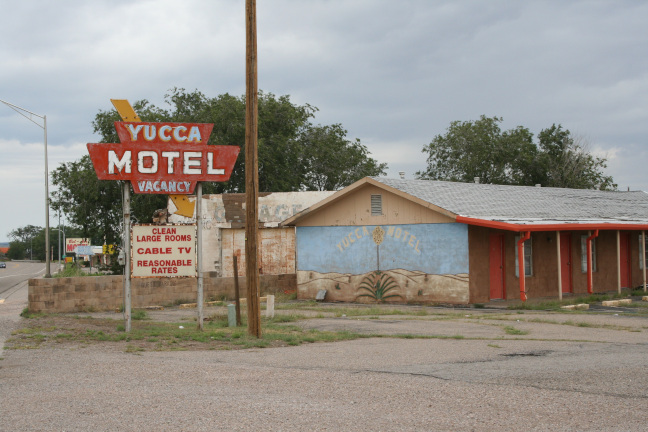

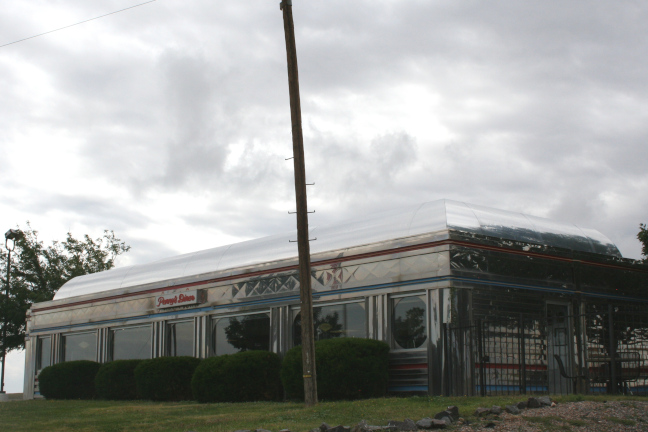
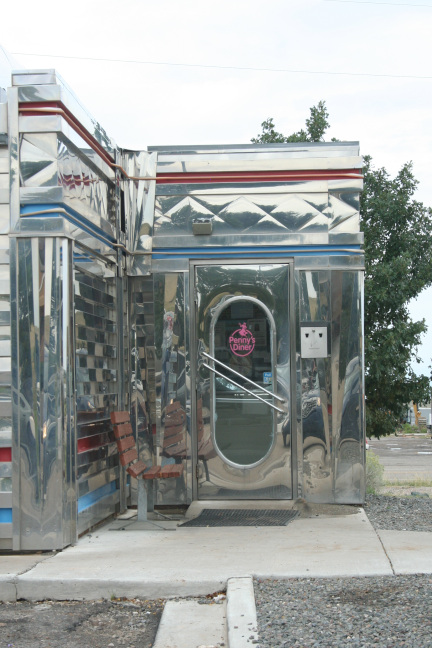
Route 60 continues on to Fort Sumner and then to Clovis. There are plenty of photo opportunities along the way. Here are just a few. If you ever travel into or through that part of New Mexico and Texas, it is worth spending the extra time to travel these older highways. Although we are not likely to ever make the trip again ourselves, we are glad to have done it when we had the chance.

